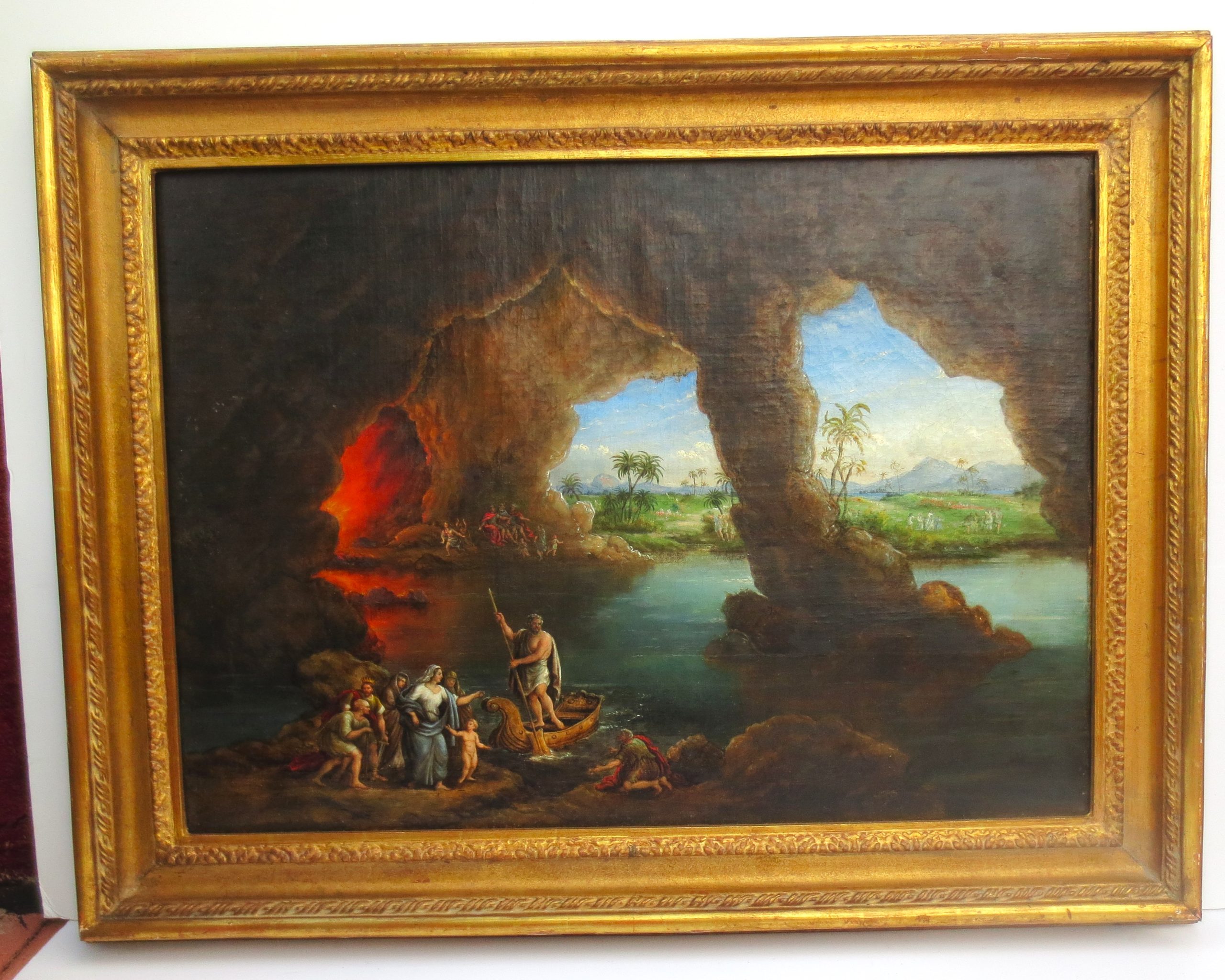Although Swiss by birth, most of Ducros’ active career was in Rome and Naples as the Italianized DuCros, with side trips to Malta and Sicily before final return to Switzerland. For most of his Italian career Ducros produced large-scaled renderings of notable Roman monuments, meticulously drawn in precise detail and watercolor tinting that were widely sought desiderata as Grand Tour souvenirs.
Although Ducros rarely painted with oil directly onto canvas, it was quite within his range as an artist who had long amplified straight watercolor washes with body colors in gouache and oil, applied oil and resin varnish glazes over select areas of color or even entire paintings. On sheets of paper joined for enlargement and glued to canvas for support, many of Ducros’ later paintings were in fact mixed in media and method, while by 1900 after stays in Sicily and Malta, he painted more frequently with oil on paper or canvas as a direct technique.
The present painting is a true oil on canvas, albeit with some suggestions of a translucently luminescent brown as a primary foundation tone glowing within the darkest segments of the rocky walls. The handling is broader than in the watercolors, with full impasto indicative of the artist’s accommodation of the shift from watercolor ink drawings to brushed oil paints. Indeed, this broader oil technique was, like the choice of subject, better suited than watercolor to a painterly contrast between dark chasms of shadow, brilliant distant skies, and the modulated reflections of the intense focal glower of the demonic fire within the dark embrace of the cave.
That virtuoso achievement was fully predicated by Ducros’ many earlier paintings with similar grotto settings that reached an apogee in this and other paintings done around his trip to Sicily and Malta, which seemingly inspired the brighter skies, still luminous water and even the palm trees. Even before, during and in maturation of his evolving shift in stylistic emphasis from a linear to a painterly mode, the grotto opening provided Ducros a frequently used compositional schema setting ensconcing a bright exterior scene in the dark arched frame of the grotto interior. Within that system, and quite evident in this painting, Ducros further extended the sense of a contained panoramic composite by introducing more than one focal vector, implying a far wider visual range than actually in the composition in toto.
Several habitual tells of handling frequently seen in Ducros’ open landscape and grotto paintings included the quilted pattern of rock walls, the discombobulated gatherings of cotton puff clouds and breaking waves. Often enough, after the manner of Bonavia in Naples, Ducros traced the edge of his grotto openings with fine white lines emphasized by white dabs of heavier paint. Even the types, actions and placement of his figure groups remain a constant throughout his career as tight gathering enlivened by demonstrative action set as colorful lighter touches against the dark walls of a cliff or grotto. However, although planned in full and calculated for placement by Ducros, the actual finishing of many of the figures in these later paintings, including this one, seem to be the work of his assistant Mazzola, a figure and costume staffage professional more recently brought to light as an obscure but skilled collaborator (cf. Pierre Chesex, “Figures,” in Chessex et al, Images of the Grand Tour: Louis Ducros 1748-1810, London-Manchester-Lausanne, 1985-6, pp.23-24).
This play of dark frame for collated figures and light vista is most prevalent with the erupting fashion for Vesuvian spectacles of explosive nocturnal flare as coupled with a reliably English interest in caves and grottos both in Naples and in the Lake Region at home. Most likely intended for both the indigenous and transitory English collectors in Naples, this less typical Ducros’ painting finds numerous analogies in Ducros’ grotto scenes that became a second specialty later in his career as a painter of iconic monument mementos. These include the Grand Duc Paul in Tivoli (1787) and the Grotte des Pages in Malta (1800-1806), each predominantly or entirely in oil colors as illustrated and discussed in Jörg Zutter, Abraham-Louis-Rodolphe Ducros: Un peintre suisse en Italie,Lausanne, 1998, as fig.13 and cat. 64 along with others of the same ilk. Some but not all of the material in the Lausanne catalogue was repeated with other essays in Pierre Chessex et al, Ducros: A Swiss Painter in Italy, Dublin, 2003 which also included several important articles on Ducros, including a study of his mercurially innovative mixed media by Westby Percival Prescott, “Ducros’ Technical Methods,” in Pierre Chessex et al, op. cit., pp. 40-44, in addition to a particularly relevant chapter by Lindsay Stainton on “Ducros and the British,” pp. 26-30.
Two particularly analogous examples of Ducros’ best late Neapolitan grotto settings, the Posillipo da Palazzo Donn’Anna (Naples, Museo di San Martino) and La Grotta del Tuono (Lausanne), are included in the essential work of Nicola Spinosa and Leonardo Di Mauro, Vedute napoletane del Settecento, Naples,1989, which offers an authoritative survey of the coterie of Neapolitan landscape painters that Ducros entered after leaving Rome, well supported by ample illustration and quite instructive critical data and insight.

